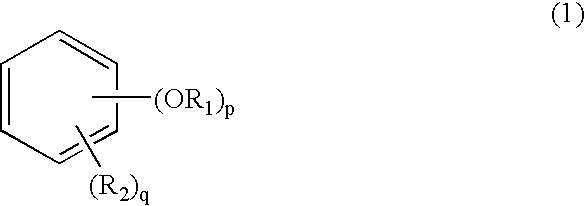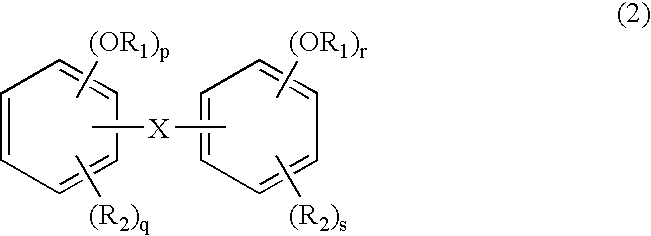Photosensitive resin composition, resist pattern forming method, substrate processing method, and device manufacturing method
- Summary
- Abstract
- Description
- Claims
- Application Information
AI Technical Summary
Benefits of technology
Problems solved by technology
Method used
Image
Examples
Example
[0027] A first embodiment of a photosensitive resin composition according to the first aspect of the present invention will be explained.
[0028] The photosensitive resin composition contains the components (A) and (B) described above and is capable of providing a high resolution (resolving power) and a high aspect ratio.
[0029] By using a photosensitive resin composition (hereinafter, simply referred to as a “resist”), it becomes possible to form a resist pattern which is low (small) in line edge roughness (“LER”) and high in aspect ratio through a surface imaging with arbitrary exposure method and subsequent selective sylylation process and dry development.
[0030] In this embodiment, as the polymer for the component (A), e.g., it is possible to use acrylic-based resin, styrene-based resin, epoxy-based resin, amide-based resin, amide-epoxy-based resin, alkyd-based resin, phenol-based resin, and the like. Of these resins, it is preferable that they does not contain hydroxyl group, ca...
Example
[0055] Next, a second embodiment of a photosensitive resin composition according to the second aspect of the present invention will be described.
[0056] The photosensitive resin composition in this embodiment is characterized by containing a polymer, as a component (A), having a monodisperse molecular weight; a radiation-sensitive acid generation agent as a component (C); and a compound, as a component (D), containing at least one functional group selected from the group consisting of hydroxyl group, carboxyl group, amino group, thiol group, and amido group, each of which is protected by an acid-dissociative group.
[0057] In this embodiment, the component (A) is the same as in the first embodiment described above.
[0058] The radiation-sensitive acid generation agent (hereinafter referred to as a “photoacid generator”) is a compound which includes chemical reaction by irradiation of radiation such as infrared radiation, visible radiation, ultraviolet radiation, 4t for ultraviolet rad...
Example
(Embodiments 1-4 and Comparative Embodiments 1 and 2)
[0086] In these embodiments, photosensitive resin compositions associated with the above described photosensitive resin composition according to the first aspect of the present invention are prepared in formulations shown in Table 1 below. TABLE 1Amount (g)Comp.Comp.ComponentMaterialEmb. 1Emb. 2Emb. 3Emb. 4Emb. 1Emb. 2(A)polystyrene*1300000(A)polystyrene*2030000(A)polystyrene*3001000(A)polystyrene*4000030(A)polystyrene*5000003(B)TM-3007791077solventPGMEA909090909090
*1Mw = 5200, Mw / Mn = 1.06
*2Mw = 2200, Mw / Mn = 1.06
*3Mw = 20000, Mw / Mn = 1.06
*4Mw = 5800, Mw / Mn = 2.0
*5Mw = 6500, Mw / Mn = 2.5
[0087] Each of the above prepared resist solutions is applied onto a silicon substrate and pre-baked on a hot plate at 100° C. for 60 sec., to form a resist layer having a thickness of 1.0 micron.
[0088] The substrate is imagewise exposed to light by i-ray stepper (wavelength=365 nm) as an exposure apparatus.
[0089] The exposed substrate is ...
PUM
 Login to View More
Login to View More Abstract
Description
Claims
Application Information
 Login to View More
Login to View More - R&D
- Intellectual Property
- Life Sciences
- Materials
- Tech Scout
- Unparalleled Data Quality
- Higher Quality Content
- 60% Fewer Hallucinations
Browse by: Latest US Patents, China's latest patents, Technical Efficacy Thesaurus, Application Domain, Technology Topic, Popular Technical Reports.
© 2025 PatSnap. All rights reserved.Legal|Privacy policy|Modern Slavery Act Transparency Statement|Sitemap|About US| Contact US: help@patsnap.com



